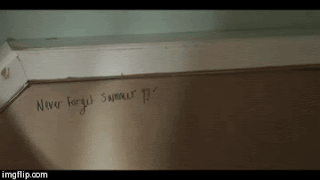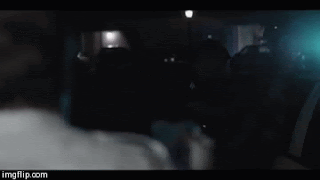Lorde's genre is usually described as indie pop, so I have chosen to analyse a music video for a song by another indie pop artist- 'Ghost' (Room 93 Version) by Halsey.
Camera Shots/Movements/Angles:
Most of the camera shots in this video appear to have been filmed using a handheld camera. The shots have an unstable, wavering quality which makes the video appear more realistic, and increases elements of tension at certain points during the video. Wide shots have been used to give the viewer an idea of the setting of the video- for example, showing a motel sign illuminated in the night lets the audience know where the video is set and during what time of day. This wide shot has been used as an establishing shot. Close up shots have been used a lot in this music video in order to show the facial expressions of the two main characters, which helps to show how they're feeling and to tell their story. Tracking shots are used in this video to create smooth transitions between settings, giving the video a sense of fluidity.
Editing Transitions:
This video contains conceptual elements- these are short clips within the video showing stationary objects such as a television, a door, and some writing on a wall. The editing is fast paced so that these clips don't distract the audience from the narrative too much, and to keep the audience interested in the storyline. The various clips in this music video change simply via jump cuts- this is how the editor made the video so fast paced. Part of the storyline in this music video shows the female lead having a brief flashback. Two clips have been overlapped here- the first clip that appears on screen is what the character is looking at (the audience realises that this is what causes her to have the flashback). A second clip appears, slightly faded over the first clip- this is the flashback. This editing technique is really effective in creating a part of the storyline that is easy to understand for the audience.
Mise-en-Scene:
The colours shown in this music video are quite subdued and muted- this effect may have been created during the editing process by decreasing the saturation of the video clips. This gives the music video a bleak quality, enhancing the narrative's sombre atmosphere. The lighting is low, which also contributes to the sombre atmosphere and reinforces the idea that this video is set at night.
The clothing worn by the people in this music video appears to be influenced by another era- possibly the 80s and/or 90s. Since trends from these eras such as crop tops, denim jackets, leather jackets and high waisted shorts have made comebacks recently, and the phrase 'Never forget summer 97' is written on a wall in this video, the audience can assume that this video is set in the modern age, despite the old fashioned television and phone shown in the video. The clothing choices in this video might be viewed as unusual and strange- this fits well with the genre of indie pop.
The setting of this video is made clear at the beginning, where a wide establishing shot shows a sign that reads 'Pink Motel'. The storyline of this music video follows on from the artist's previous release 'Hurricane', which ends with a shot of the same sign. Having this shot in both videos emphasises the importance of the location of this music video to the storyline. The motel in which this video is set appears to be fairly run down- the phone and television are relatively old fashioned and the room number '93' is almost peeling off of the door. The setting goes well with the desolate and dreary atmosphere in this video.
Representation
In this music video, the artist is represented as a vulnerable yet tough character. Close-up shots of the artists tattoos have been included in this video, and since tattoos are often painful, they are associated with being strong. Focusing on the artist's tattoos means that the audience is given the impression that the artist is a strong person. The artist is also shown arguing with and then slapping the male lead in the video. The man does not retaliate, showing that the woman (the artist) is dominant and powerful. A High Angle shot is used as the man reacts to the slap- this filming technique reinforces the idea that the female lead in this music video is dominant. On the other hand, at the end of the video, the representation of the artist changes dramatically. The artist is shown swallowing a handful of pills, then later being removed from the motel room on a stretcher. Low Key lighting has been used for these shots to symbolise that something more powerful than the artist has taken control of her actions. This emphasises the idea that the artist is represented as vulnerable at the end of the video.
Genre of the music and how this is signified in the video
As mentioned previously, the genre of the music is indie pop. I think that the low saturation and muted quality of the colours in the video are indicative of the genre of music, as this is a common feature in alternative pop videos. The main characters in the video are young adults, and as Indie Pop is quite a modern and newly popular genre of music, the age of the characters in the video reflects this.
Intertextuality
There are no clear intertextual references within this music video. This is probably due to the genre being Indie Pop- the association of mainstream media is not a common feature for an Indie Pop music video to have.
Audience Reception
Stuart Hall's Audience Reception Theory demonstrates three ways in which an audience might read a media text. The theory of preferred reading is when the audience reads the text the way the author intended them to. The theory of negotiated reading is when the audience reads the text the way the author intended, but also uses their personal experiences and interests to modify their interpretation. The third theory is the oppositional reading theory, where the readers' social position means that they have an opposing relation to the text. Therefore, they reject the reading.
For Halsey's 'Ghost' video, I think that the theory of preferred reading is the most relevant as there is a clear storyline for the audience to follow, therefore, they view the video the way that the artist intended. The theory of negotiated reading could also be applied to this video as a viewer could use their own positions and experiences to interpret certain elements of the storyline.
Uses & Gratifications- Why might an audience enjoy this video?
The Uses and Gratifications theory suggests that audience members are not passive, but take an active role in integrating media into their lives. It also states that audiences are responsible for choosing certain medias to meet their needs. It focuses on what people choose to do with media rather than the effect that the media has upon them. I think that an audience might watch this video to fulfil entertainment needs, as it has a compelling and gripping storyline.
Can Andrew Goodwin's theory be applied to the video? If so, where?
I think that elements of Andrew Goodwin's theory can be applied to this music video. For example, the video expresses genre characteristics such as a muted and dull colour scheme, and the involvement of both concept and narrative aspects. However, there aren't many clear close-ups of the artist in the video, there are no links between lyrics and visuals, no links between music and visuals, and no intertextual references.
Can Laura Mulvey's theory be applied to the video? If so, where?
Laura Mulvey coined the term 'Male Gaze', and believes that film audiences must view characters from the perspective of a heterosexual male. Her 'gaze' theory is made up of 3 aspects- how men look at women, how women look at themselves and how women look at other women.
The 'Male Gaze' theory states that the camera lingers on the curves of the female body, and the events that happen to her afterwards are largely based upon the male's reaction to this. It also demotes women to the status of objects, and gives the female viewer a secondhand experience of the narrative through identification with the male on screen.
I don't think that Laura Mulvey's theory can be applied to this music video, as the female body is not really focused on.
Are there any Binary Oppositions in the video? If so, where?
Levi Strauss came up with the theory of binary opposites. A protagonist and antagonist, or a hero and villain are typical examples of binary opposites. In this music video, it could be argued that the male lead is the antagonist, and the female lead is the protagonist. This is backed up by the arrest of the male lead at the end of the video, and the vulnerable and fragile state of the female lead at the end of the video. The two characters are seen arguing throughout the narrative, so despite the fact that the female lead swallows the pills herself, it could still be interpreted as the male's fault, making him the antagonist. The male also calls the police who later arrest him, making it even more unclear whether he is an antagonist or not. Overall, I am uncertain whether there are any clear Binary Opposites in this music video, but I think that it could definitely be interpreted as a hero/villain story.












No comments:
Post a Comment